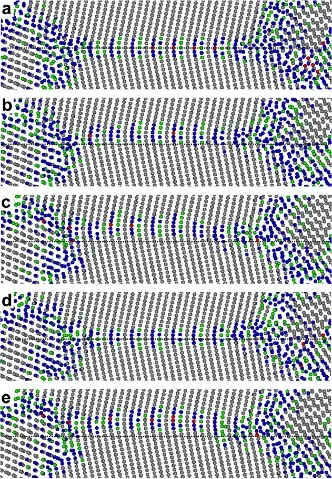Stress-driven grain boundary motion, a mechanism already observed in 1953, has been suggested as a possible plasticity mechanism explaining the rapid grain coarsening in nanocrystalline and ultrafine grained metals during deformation. Molecular dynamics simulations performed on bicrystal configurations, confirmed the coupling of symmetrical tilt boundaries to shear deformation. It was shown that grain boundaries (GBs) can move by deformation of their structural units, accompanied by relatively small and highly correlated “military” displacements of atomic sites. The coupling factor between the GB motion and grain translation has been calculated by molecular dynamics (MD) simulations for several tilt boundaries and was shown to depend strongly on the tilt angle and the deformation mode but less on temperature. However, at high temperatures, coupling is gradually replaced by sliding. Similar simulations have been performed on Al bicrystals including diluted oxygen impurities, evidencing that the mechanism
is hindered but is not inhibited by such impurities. Recently it has been shown that also asymmetrical tilt boundaries can couple to shear and a more general theoretical model for coupled GB motion was presented.
Although direct evidence of stress-driven GB motion has been provided in in situ transmission electron microscopy (TEM) experiments performed on nanocrystalline or ultrafine grained metals during indentation or tensile deformation, in each of these experiments the GB network can be compared to a columnar structure because of the required thinning procedure for TEM observations.
In this research project molecular dynamics computer simulations have been performed on a nanocrystalline sample containing a symmetrical tilt boundary, showing that such a boundary can migrate with similar coupling factor when embedded in a full three-dimensional (3-D) grain boundary network as when simulated in a bicrystal. The influence of the triple junctions and the accommodation processes in the surrounding GBs on coupled grain boundary motion is examinated ( link to our paper)
In this research project molecular dynamics computer simulations have been performed on a nanocrystalline sample containing a symmetrical tilt boundary, showing that such a boundary can migrate with similar coupling factor when embedded in a full three-dimensional (3-D) grain boundary network as when simulated in a bicrystal. The influence of the triple junctions and the accommodation processes in the surrounding GBs on coupled grain boundary motion is examinated ( link to our paper)
